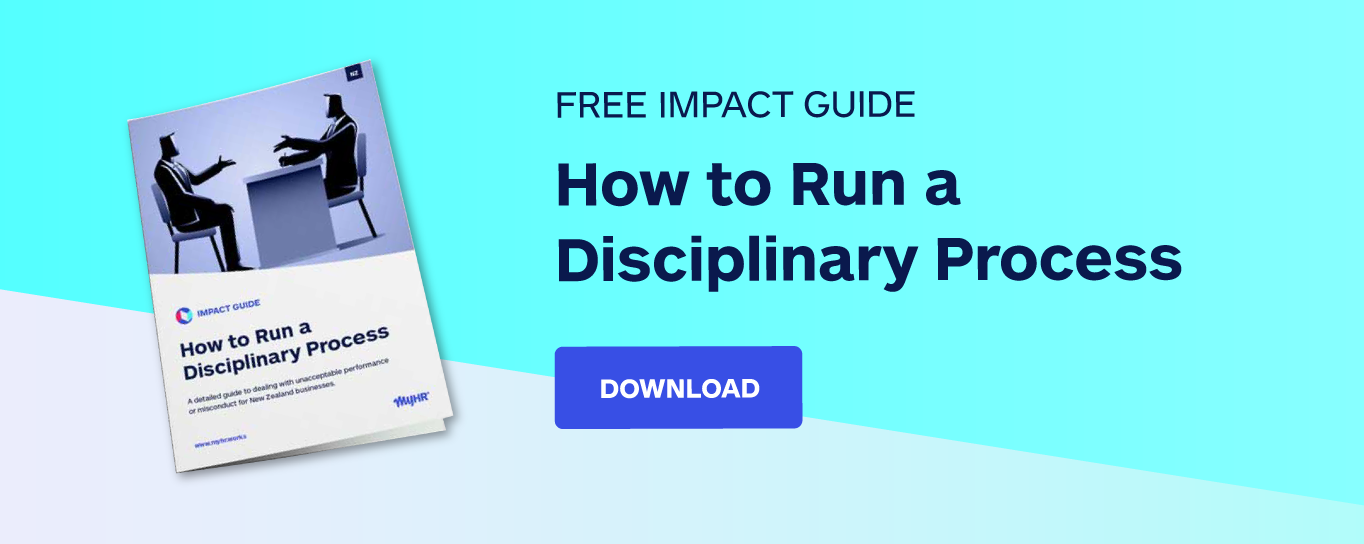Meeting with the employee is an essential step in the disciplinary process. It gives the person a fair opportunity to respond to any concerns about their behaviour or allegations of misconduct made against them.
All employees must be given the opportunity to present their side of the story, no matter how obvious or definitive the allegations may appear. It is natural justice.
These meetings (better known as employee response meetings) aren’t always relaxed or easy, so following good procedure will help minimise stress and ensure you follow fair process in reaching any decision.
As with any step in the disciplinary process, the procedure for arriving at a decision is as important as the reason for taking the action in the first place.
Not conducting a meeting fairly or missing out any steps may make the outcome of the disciplinary process unfair and invalid, which could mean you face personal grievance action and have to pay compensation and legal bills. In some cases, if the dismissal is ruled to be unfair the employee may be given their job back.
So once you have determined there is good cause to start disciplinary action, fully investigated the issue (including checking the employment agreement, any company policies, and talking to witnesses), advised the employee in writing, and given them time to prepare their response, you will be ready to sit down with the employee and their representative or support person to hear their side of the story.
The disciplinary process

Structuring the meeting
There are some standard steps you should follow to ensure you handle the response meeting properly:
Opening
Welcome everyone to the meeting and introduce each person and they role they play. Meetings run better when everyone in the room knows who the others are.
State the meeting purpose
Remind the employee (and their representative/support person) that the meeting is their opportunity to formally respond to the allegations against them. It is a good idea to also let them know that what they say is pivotal in deciding the outcome of the disciplinary process.
The meeting is “on the record”, so take notes.
Check they have a support person
If the employee has come on their own, check that they have taken the opportunity to get advice and/or support. If they haven’t brought somebody along, check and confirm that they are happy to go ahead without one. Write this in your notes.
Confirm they have reviewed all the information
Check that the employee has read through the information and evidence you gave them. Give them the opportunity to ask any questions about the allegations or whether there is any additional information they would like.
Employee's response
Give the employee and/or their representative a chance to respond fully to the allegations. This is their time to talk openly, so don't rush them and listen attentively.
The employee may choose to only give a written response. This usually happens when the employee is uncomfortable speaking to the employer, or English isn’t their first language (and someone else has translated or helped write the response), or when arranging a face-to-face or phone meeting isn’t going to happen within a reasonable time-frame.
A face-to-face meeting is better for managing the human side of the process, but there is no legal obligation for the employee to respond or speak to their response. They only have to be given the opportunity.
Employer’s questions
You can ask questions about the details of the employee’s response. We recommend you do when they finish, so as not to interrupt them. Let them have their say, even if you don’t agree with their statements. Make notes of anything you want to know more about, or anything you don’t entirely agree with.
It is important your clarifying questions don’t indicate that you have already made up your mind.
You may also attend the meeting with some additional questions you would like addressed. This is particularly useful if the employee’s response glosses over any key points.
Remember, this is the employee’s response first and foremost. Your questions should help you make the right decisions at the next stage of the process; they can be direct, but clarifying questions are not an interrogation.
Summarise
Once they finish giving their response, check that they have said all they want to. Then outline what you heard and ask them if your summary is a fair representation of their response.
Closing
Draw the meeting to a close by thanking the employee (and their representative) and reiterate your intention to carefully consider their explanation before making a decision.
The employee may have provided a very reasonable explanation for what they did or highlighted a problem within the business that was out of their control, so there may be no further action needed.
Their response may have also provided new information or raised an issue you hadn't previously considered, so you may have to do more investigation or talk to other people to corroborate. If so, explain this to the employee.
Outline the next steps in the process and any likely timeframes, including when you aim to come to a decision. Then let them know you will be in touch to make arrangements for the next meeting (either to give them an opportunity to comment on any new information or to provide your preliminary decision).
Key things to watch out for
Fair process
Employment law requires that you must follow a fair and reasonable process. However, there is no need to over-prescribe this by stipulating a disciplinary procedure in employment agreements or policy.
We see many successful personal grievances where an employer has failed to follow their own process. Overly prescriptive processes can create too much extra work and if you don’t follow them strictly, you will breach your own rules.
Human behaviour and reactions mean that each individual process is slightly different, so don’t shackle yourself to a rigid process.
Give the employee fair opportunity to respond
Always keep front of mind that the purpose of the meeting is to give the employee a chance to explain.
This means giving them time to talk and listening carefully to what they say. The meeting is not a grilling, so you shouldn't try to dominate the process by interrupting with lots of questions.
Likewise, being dismissive doesn't help, so resist the urge to roll your eyes, yawn, or “tut-tut” at their explanations.
It's also a good idea to ask the employee what they would see as an appropriate outcome.
Keep an open mind
Don't go into the meeting with a predetermined outcome. No decisions are final until the employee has had the chance to speak and you have considered their response and factored it into your decision.
It is not uncommon to change your mind once you hear from the employee.
Once again, the meeting process is essential.
The role of the support person or representative
Both parties are legally entitled to have a support person, advocate or representative with them at the meeting if they want to. You must provide this option to the employee.
It could be a family member or friend, or a more formal representative, e.g. a union delegate, lawyer, or employment specialist.
During the meeting, these people have the right to ask questions or provide further information on behalf of the employee or employer (a representative will typically speak for an employee but a support person should let the employee do most of the talking).
This doesn't mean they can dominate or hijack the process; the employer is allowed to ask questions directly to the employee, too, and the employee must respond.
Keep a written record
Write down what is said during the meeting. You won't have to rely on memory when it comes to making decisions and documenting everything in writing provides evidence both of the process and any outcome.
Either party can request to record the meeting, but only if the other party agrees. If the employee or their representative asks, you can refuse. Ultimately it is up to you, but we recommend not recording the meeting, as we have found audio recordings can alter the tone of the meeting, stifle open discussion, and be used out of context. Taking written notes is much more effective.
After the meeting
The response meeting may not be the end of the process. It can be easy to fall into the trap of thinking you’ve ticked the meeting box so now you can get on with the formal warning or dismissal.
Any disciplinary action must be for good reason and come as the result of fair process, so give yourself some time to consider the outcome.
If the employee raises legitimate concerns, you are obliged to investigate them further, and then potentially have another response meeting.
The employee’s response may not provide any new information to significantly change the situation and therefore, after considering everything, you determine disciplinary action is the reasonable outcome.
Unless the misconduct is serious and deliberate, offering the person an opportunity to improve their behaviour is better than dismissal. Look at providing any necessary support or training. There may also be things the business needs to do to ensure good employee conduct, such as improving its processes or policies.
Then if the employee’s behaviour still doesn't improve, you will know you have given them a fair chance and done all you can to fulfil your legal obligations.
Frequently asked questions
Get answers to more common questions about the disciplinary process.
-1.jpg)




